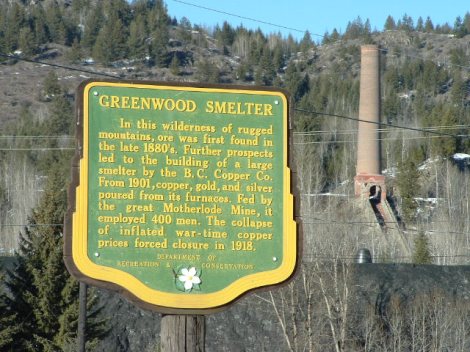
Image source: http://bcadayatatime.com
Greenwood, British Columbia is known as Canada‘s smallest city. Given its status in the late 1800’s during a gold rush boom, though the population decreased to a current total of about 600, the title stood.
Greenwood is also the location of a famous ‘lost mine’, and the tallest, longest, most horrendous, 100 year old black ‘slag’ pile I have ever seen.
Slag, refuse from the copper mining industry, literally cuts Greenwood off from the local woods. The town is surrounded by a multi-story tall, black tar looking impenetrable wall – and has been since before 1918.
The 1998 movie ‘Snow Falling on Cedars‘, about Japanese-American internment, was filmed here. According to hellobc.com, the location was chosen in part because of the ‘Japanese look’ of many of the town residents. They were perfect for extras in the film.
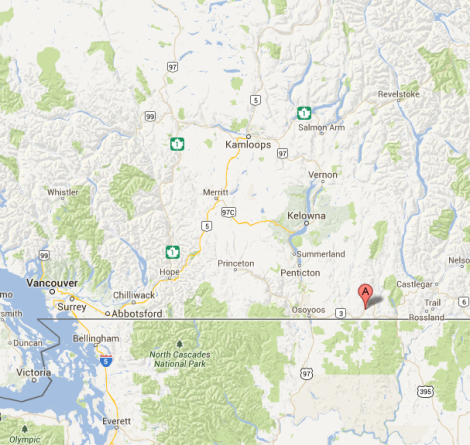
A = Greenwood, BC
That’s not all Greenwood is (in)famous for though. In 1942, approximately 1,200 Canadian-Japanese persons were sent here for internment.
At the time, Greenwood’s population had dwindled to 200, and the economy was in a serious state of long term decline. It was going on three decades since the closing of the mine. Greenwood needed people.
Surprisingly, locals welcomed the new residents. From hellobc.com;
Greenwood welcomed these displaced people and the two communities got on well together. After the war, many returned and made Greenwood their home, permanently transforming the character of the tiny city.
Look a little deeper and see the remnants of one of the most shameful episodes in this country’s history, and one of its best stories of healing and redemption.
They ran shops, worked their chosen professions and lived (almost) a ‘free life’ (as long as they stayed near ‘home’) amongst the greatly out-numbered locals. They married – and reproduced – with whites and natives.
In fact, Japanese internment saved Greenwood from ultimately becoming a ghost town. It was well on its way toward that status by 1942.
The Greenwood museum holds great artifacts and stories from this time.
Not everywhere was so accepting of their new Japanese residents. Some of the worst, harshest interment camps were located only a few short kilometres away.
When the war ended, and the interned Japanese were forced to relocate east or to Japan, Greenwood was the one place that held fast and refused to take part in the deportation. If you lived in Greenwood – no matter what brought you there – you were not going to be forced out. Here, the Japanese were wanted.
Why did Greenwood choose to be welcoming?
Perhaps it had something to do with its status as the first BC internment camp, maybe it was desperation due to the economy and a lack of manpower, it could have been the collective belief system of the locals, or maybe it was simply an amazing accident.
Either way, the residents are proud of their history, and proud of the fact that many Japanese never left (once they were able), and still choose to raise children, and grandchildren, in the town they were once forcefully relocated to.
Indeed, Greenwood has unique status as a Japanese wild west gold rush town. Because of the internment, and resulting population/economy/manpower increase, it has some of the greatest preserved ‘old west’ buildings in all of BC.
Buildings that would have been dust by now, if it had not been for the Japanese-Canadians, and a few steadfast open-minded locals.
I know I will be spending a few hours in the museum on my next visit, to see if I can figure out what separated Greenwood from other locations, many famous for brutal racism, discrimination and abhorrent treatment of the interned Japanese.
The Greenwood story shows us that if you stand hard enough for what is good, and what you believe, sometimes a handful of decent people can make big change that ultimately effects thousands – and history.
And about that slag? Well, it looks like a new technology may be able to help with removing that hideous pile. Not only does it seem to have some value, but it also looks like it can be turned into solar panels.
How fantastic would that be – to eliminate the heap that has loomed over Greenwood for a century – and turn it into an efficient clean energy source?! Fantastic.
I can’t wait to go back.
Many additional photos in the slideshow. Click any picture above to view images in a larger format.
Follow our tour in the ‘WWII Japanese Internment‘ section, or head to the Habitual Runaway on Facebook for more photos.
Related articles
- Greenwood (welcomemat.ca)
- Greenwood BC, Canada (ernestartist.org)
- Greenwood City (greenwoodcity.com)
- Slag to Solar (boundarysentinel.com)
- Culture and History Greenwood (hellobc.com)



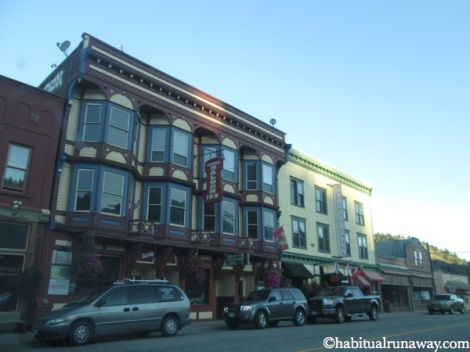
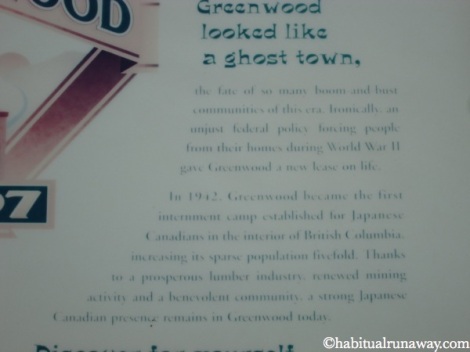
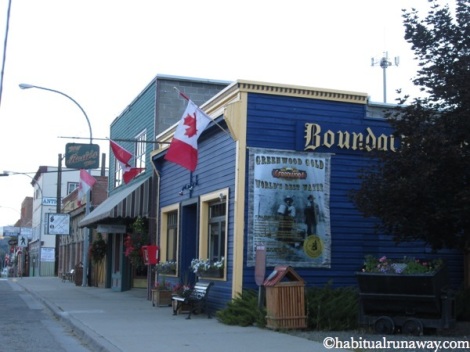
Very interesting! I knew nothing at all about Greenwood before reading this post. Thank you.
LikeLike
I didn’t know that they were so welcoming until I read it on a plaque while there. Then I did some research & the stories were INCREDIBLE. Quite something, all things considered. Made me cry!
LikeLike
Great recap of Geenwood history! The slag, both in Grand Forks and Greenwood is large part of that. Untold amounts have been exported for years now. It is somewhat of a value added resource that has been utilized for many years by a gentleman in Grand Forks who uses it to make fabulous headstones and numerous monuments that are on display in small cities is the area. I love the slag myself, its also great place to discover rattlesnakes, and makes for some fabulous photography!
LikeLike
Oh goodness – slag for gravestones – how unusual! It is good to hear a different perspective on the slag – VERY interesting to photograph for sure. Surreal to someone who has never seen a monster slag pile before (me!)!
LikeLike
Thank you for this post and the previous one.
I grew up in Greenwood during the 60s and 70s. My ancestry is European. I thought everybody grew up with people of differing heritage/race/religion/backgrounds. My grade 2 and grade 5 teachers were Japanese-Canadians (so kind and gentle and inspiring). My first crushes were on particular girls of Japanese heritage (so sweet and shy and beautiful). Many of my buddies from Greenwood are of Japanese heritage (boys become men of excellent character).
I was shocked by the prejudice/racism we encountered in high school from kids who came from the western part of our school district. I was proud of the older Greenwood boys who had zero tolerance for any racist comments from those western kids.
Being raised in Greenwood led me to have zero tolerance for any kind of racism/prejudice. I have tried to pass that on to my children and everyone I meet.
<> I am disgusted by the racism/prejudice my fellow Canadians exhibited toward Japanese-Canadians and many others in the past. Unfortunately, in my opinion, our country continues to exhibit prejudice.
We have maltreated Aboriginal people and their descendants from the beginning and continue to do so. Apparently, just this month, our media has neglected to report on the devastating flood consequences in Aboriginal communities near Calgary.
Also our government has exhibited prejudice toward Muslim-Canadians in recent years. I met Maher Arar before he was deported to Syria and tortured. I visited with him after he was finally returned. Mohamed Harkat was my children’s piano teacher’s son-in-law. He is still fighting deportation orders. It is my understanding that he has been imprisoned for years based on secret evidence without due process of law because of immigration loop-holes.
As a country we continue to exhibit disgusting behaviour toward some of our fellow countrymen and human beings. <>
Thank you again for this excellent post. You have a new follower.
LikeLike
Thank you so much for your comment. It is fantastic to hear from someone who grew up in Greenwood – better than just reading about it. I have to say, I love your hometown & its incredible history!
I cannot agree with you more about our Canadian propensity toward racism. I have a terrible story about trying to find a place to live in Edmonton Alberta – as I was calling rental ads, the people were actually asking me if I was Native – flat out telling me they don’t rent to Native people – and even after I told them I was employed.
Can you imagine? Hideous & shameful. And that is saying nothing of how we treat Muslims – you are right about that too.
Ahhhh Canada – so good and so bad, all at the same time.
Thanks again for your input :).
LikeLike
What a wonderful history and and human nature lesson. I didn’t know anything about the Canadian Interment camps. In fact, when I went to high school (a million years ago!) I don’t remember even studying about internment in the US. Thanks for the great lesson. 🙂
LikeLike
I don’t remember learning about them in school either. The older I get the more I wonder – what was I learning in history?!! 😛
Greenwood history – fascinating, isn’t it?
LikeLike
Very! 🙂 I love what they did! 🙂
LikeLike
I know – heartwarming, right? 😀
LikeLike
Very! 🙂
LikeLike
My bookgroup read Heart Mountain about a internment camp in Wyoming. As I was reading your post, Iwondered if there was more prejudice than might be thought. Paul (above comment) indicated that there was quite a bit.
I always think it’s just Americans that are so racist /prejudiced. Those like myself who are not, tend to think of Canadians as perfect 🙂
Interesting post!
LikeLike
Oh yes, HUGE racism – Canada still struggles with its racism issues (in my opinion & experience). Actually, eventually I will do an article about how Hitler used Canada as an example for his internment camps. As a matter of fact, the first building used was named ‘Kanata’ after us. We did terrible things to the Natives & Ukrainians too… (*ugh*).
Canada is NOT perfect – we have a horrible history, just like everywhere else!
Thank you for the read & comment :).
LikeLike